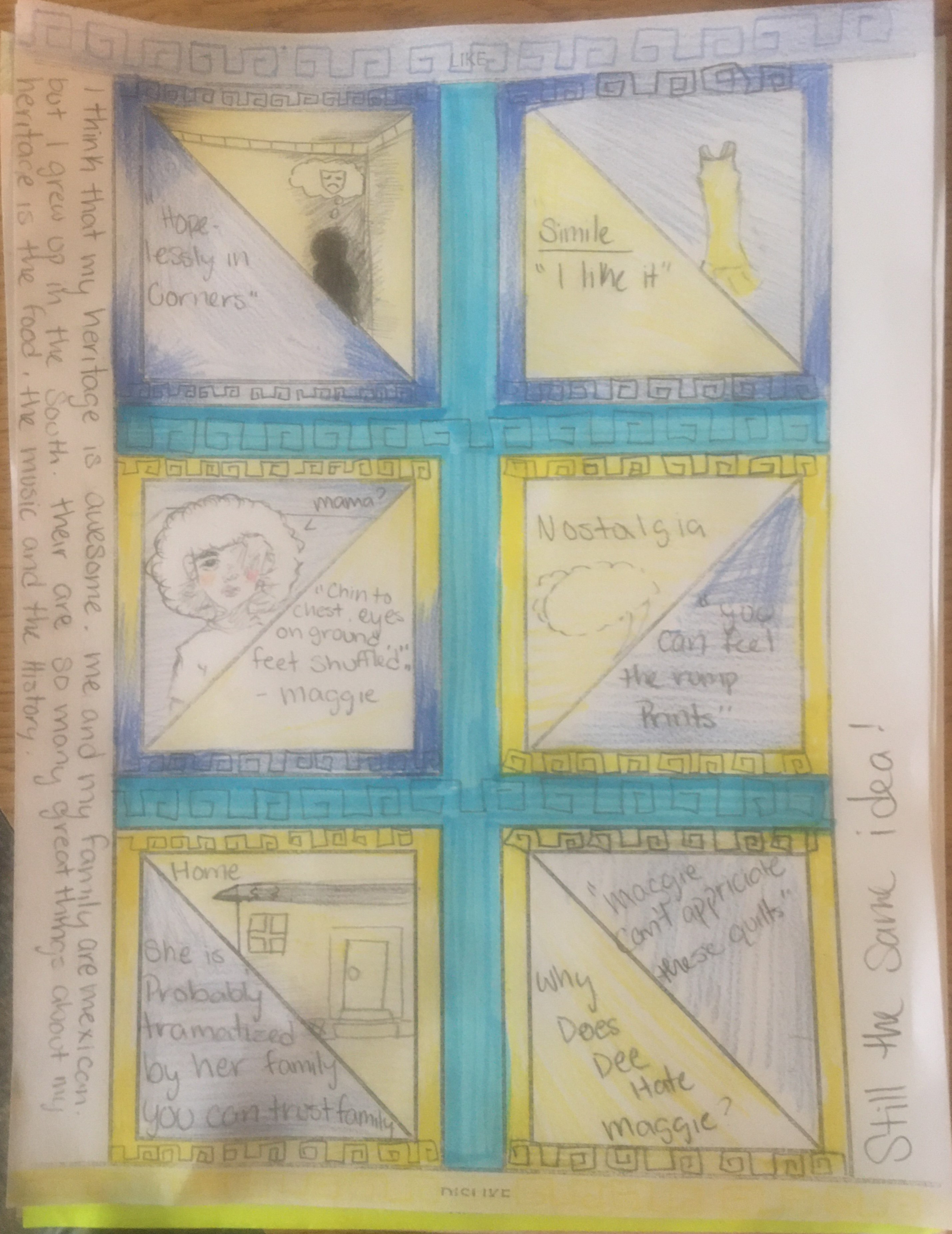

Students will practice comprehending the literal and figurative meanings of a short story in order to analyze its themes.
"Everyday Use" by Alice Walker (1973)
ELAGSE11-12RL2: Determine two or more themes or central ideas of text and analyze their development over the course of the text, including how they interact and build on one another to produce a complex account; provide an objective summary of the text.
ELAGSE11-12RL4: Determine the meaning of words and phrases as they are used in the text, including figurative and connotative meanings; analyze the impact of specific word choices on meaning and tone, including words with multiple meanings or language that is particularly fresh, engaging, or beautiful.
Topic, theme, imagery, characterization, metaphor, simile

This lesson was used as one of our first few forays into identifying and analyzing themes in fiction. By this point, students had been introduced to the idea, but hadn't practiced identifying themes in texts longer than a single poem. As we were gearing up to read the play A Raisin in the Sun by Lorraine Hansberry later in our fiction unit, I wanted to start off with a short story that covered some similar themes. Luckily, our school library had copies of the play that included several related works anthologized in the back, and so "Everyday Use" was both fitting and convenient for us to use.
Earlier in the week (2/26/24), I had designed an activity that involved creating psuedo book jackets [materials here], after which several students went out of their way to ask me if we could do more crafty paper-work like that. Of course I wanted to oblige anything that was getting them more engaged than usual, so I put on my thinking cap and got to work. Because "Everyday Use" features a handmade quilt as a significant symbol, I wanted to do something with that. At first I considered a project where each student would create a single patch of the quilt as we put it together, but that didn't seem like it would fill up enough time for a complete class period (although I would like to try that out another time). What if, instead, each student made their own mini-quilt, with a short activity for each square?
Here's the printable template I ended up creating [materials here]:

In this template, each defined "box" corresponds to one discrete activity. Based on my observations in class so far, it seemed like students' attention usually began flagging after a page or two of reading, so I decided that we should take a break to actually do something at the end of each page. Since there were about 6 pages of "Everyday Use," I ended up with 6 boxes, but this template could easily be edited to have more or less spaces, depending on your text.
Another thing I had noticed and learned from our book jacket activity was that many of my students were able to enagage more easily and for longer when things were chunked up into super-small single-step directions. That way, it would feel like doing 10 tiny tasks in a row, rather than one giant, impossible task. This seemed to be extra helpful for my students with Specific Learning Disabilities who especially need more time for activities with complex directions. Chunking it up like this also made it easier for me to create more frequent intervals for walking around to check in for understanding and focus.
Here's how I broke it down [materials here]:
Despite being quite literally a "fill in the box" assignment, I tried to make room around that structure for self-expression. Students could use whatever colors they liked best, and were continually invited to show whether or not they thought the story was any good in a very low-stakes way. Also, because each mini-prompt was tracked to a single page, I could be sure that that one page had many different examples of the target literary element. That way, students would have the best opportunity to play with whichever examples they really did like, rather than having to seek out one "right" answer. For the students who're more inclined towards drawing than writing, there were several opporunities for drawing out their ideas, plus all the blank space that several of them chose to fill in with decorative doodles.
Here's one of the artsy papers I'm going to hold onto as an exemplar for next year:

You might notice that some of the square borders are filled in with a mix of colors, rather than one pure color to show either "like" or "dislike." I hadn't suggested that option of "mixed feelings" when I was giving instructions, but one student cleverly suggested it to me as I was walking around. It turned out that many other kids also liked that idea, so I'll hold onto that for next year too. Thanks, guys!
The final piece of this activity was a quick writing assignment based on whichever literary elements and themes they had already identified. This was essentially a slimmed-down version of what I would later expect them to write for a body paragraph in their final theme analysis essay. By trying it out now, I was able to get a better idea of how prepared they were for that type of writing and what skills I would need to focus on more throughout the rest of the unit.


.